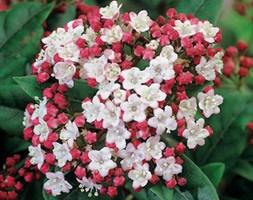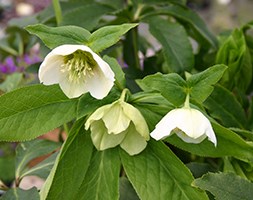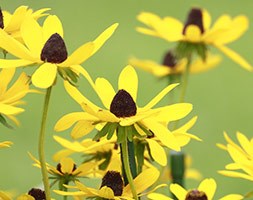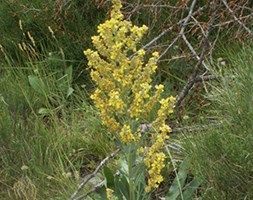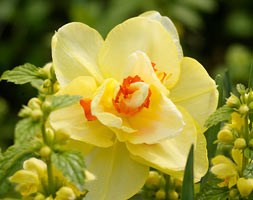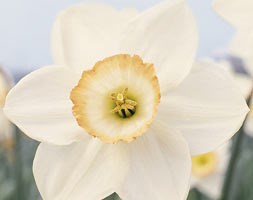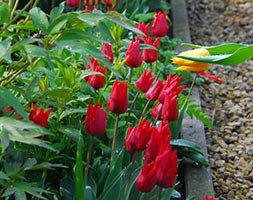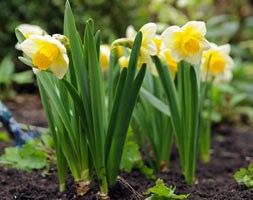New products at Crocus
by Sarah - September 11th, 2013.Filed under: Crocus, New Products.
Crocus just added these new items
Viburnum tinus ‘Lisaroze’ (laurustinus) £12.99
Position: full sun or partial shade Soil: moderately fertile, moist, well-drained soil Rate of growth: average Flowering period: December to April Flower colour: white with red buds Other features: the fruits can cause a mild stomach-ache if ingested Hardiness: fully hardy Garden care: Remove any over-vigorous shoots that threaten the shape of established specimens in early summer, cutting them well back to within the plant’s outline.
Helleborus x hybridus ‘Yellow Lady’ (Lady Series) (hellebore) £8.99
Position: partial shade Soil: heavy, neutral to alkaline soil Rate of growth: average Flowering period: February to April Other features: all parts of the plant cause severe discomfort if ingested; the sap may cause skin irritation Hardiness: fully hardy This tough and tolerant clump-forming perennial will produce its beautiful burgundy spotted, lemon yellow flowers from late winter to mid-spring. Plant it in shady gaps throughout the border and bump up the dispaly by underpinning it with spring flowering bulbs like crocus and daffodils. It also looks wonderful when planted at the feet of one of the Cornus that have brightly coloured stems. Garden care: Add lots of well-rotted leaf mould or organic matter to the planting hole. Apply a generous 5-7cm (2-3in) mulch of well-rotted organic matter around the base of the plant in autumn and provide a top-dressing of general fertiliser each spring.
Rudbeckia triloba (brown-eyed Susan) £7.99
Position: full sun Soil: moderately fertile, preferably heavy but well-drained soil Rate of growth: average Flowering period: July to October Flower colour: golden yellow Hardiness: fully hardy This marvellous plant will give you lashings of sunny, daisly-like flowers from midsummer to mid- to late autumn. It’s perfect for adding late colour to mixed or herbaceous borders and is also sublime in a prairie-style setting, where it mixes easily with ornamental grasses. Noted for its abundance of flowers, it may be a little short-lived (2-3 years), so allow some of the seedlings to become established to ensure a continuous display. Garden care: Lift and divide congested colonies in autumn or spring. Support with ring stakes or brushwood well before the flowers appear.
Verbascum lychnitis (mullein) £7.99
Position: full sun Soil: poor, well-drained, alkaline soil Rate of growth: average Flowering period: June to August Hardiness: fully hardy (but short-lived) The densely packed, branching flowerspike of this British native creates an impressive silhouette, which is useful for adding structure to more naturalised planting schemes. The flowers are mainly white (often with a hint of greenish yellow) and these contrast well with the silvery-grey foliage. A biennial plant that self-seeds freely, so in the right spot there will always be new seedlings coming through. An easy and undemanding plant that will thrive in chalky soils. Garden care:Apply a 5-7cm (2-3in) mulch around the base of the plant in autumn to protect from winter extremes, taking care not to cover the crown. Stake in spring with bamboo canes or twiggy prunings before the flowers appear. Mullein moth caterpillars can be a problem, pick off the insects in early June as soon as they appear. Remove faded flower spikes. It is worth keeping in mind that these plants are mainly biennial, so although they usually self-seed freely, the plant will only live for two years.
Narcissus ‘Tahiti’ (daffodil bulbs) £4.99
Position: full sun or partial shade Soil: well-drained soil Rate of growth: average Flowering period: Flower colour: Other features: excellent as cut-flowers; contact with the sap may cause skin irritation Hardiness: fully hardy Bulb Size: 12/14 Garden care: Plant 10-15cm (4-6in) deep from late summer to early autumn. After flowering feed with a balanced fertiliser, dead-head and allow the leaves to die back naturally.
Narcissus ‘High Society’ (daffodil bulbs) £4.99
Position: full sun or partial shade Soil: well-drained soil Rate of growth: average Flowering period: Flower colour: Other features: excellent as cut-flowers; contact with the sap may cause skin irritation Hardiness: fully hardy Bulb Size: 12/14 Garden care: Plant 10-15cm (4-6in) deep from late summer to early autumn. After flowering feed with a balanced fertiliser, dead-head and allow the leaves to die back naturally.
Tulipa ‘Ile de France’ (triumph tulip bulbs) £4.99
Position: full sun Soil: fertile, well-drained soil Rate of growth: average Flowering period: April to May Flower colour: red Hardiness: fully hardy Bulb size: 11/12 Glowing red, well-shaped flowers, each with a fine yellowish petal edge, top the stout stems in sprng, adding vibrant colour to the bedding scheme. They last well (even in poor weather conditions) and are great for cutting. Mix with rich golds and orange shades, or tuck it in with deep purples for a dazzling display. Garden care: In September to December plant bulbs 15-20cm deep and 10-15cm apart in fertile, well-drained soil. Alternatively, allow 7-9 bulbs per 30cm sq. After flowering dead-head and apply a balanced liquid fertiliser each week for the first month. Once the foliage has died down naturally lift the bulbs and store in a cool greenhouse.
Narcissus ‘Salome’ (daffodil bulbs) £3.99
Position: full sun or partial shade Soil: well-drained soil Rate of growth: average Flowering period: March to April Hardiness: fully hardy Bulb Size: 12/14 The flowers of this large-cupped daffodil can grow up to 9cm across, so they put on an impressive display when they appear in early spring. One of the most intriguing features of this pretty daff however is they way the ruffled cup changes in colour from butter yellw to apricot as the flower matures. Bred in Ireland in 1958 by Lionel Richardson, it is still as popular today as it ever was. Garden care: Plant 10-15cm (4-6in) deep from late summer to early autumn. After flowering feed with a balanced fertiliser, dead-head and allow the leaves to die back naturally.







